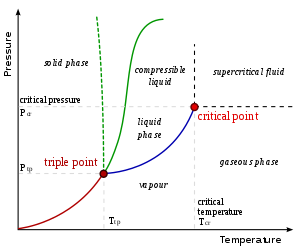The Clausius–Clapeyron relation, named after Rudolf Clausius and Benoît Paul Émile Clapeyron, specifies the temperature dependence of pressure, most importantly vapor pressure, at a discontinuous phase transition between two phases of matter of a single constituent. Its relevance to meteorology and climatology is the increase of the water-holding capacity of the atmosphere by about 7% for every 1 °C (1.8 °F) rise in temperature.
Definition
Exact Clapeyron equation
On a pressure–temperature (P–T) diagram, for any phase change the line separating the two phases is known as the coexistence curve. The Clapeyron relation gives the slope of the tangents to this curve. Mathematically,
where is the slope of the tangent to the coexistence curve at any point, is the specific latent heat, is the temperature, is the specific volume change of the phase transition, and is the specific entropy change of the phase transition.
Clausius–Clapeyron equation
The Clausius–Clapeyron equation applies to vaporization of liquids where vapor follows ideal gas law and liquid volume is neglected as being much smaller than vapor volume V. It is often used to calculate vapor pressure of a liquid.
The equation expresses this in a more convenient form just in terms of the latent heat, for moderate temperatures and pressures.
Derivations
Derivation from state postulate
Using the state postulate, take the specific entropy for a homogeneous substance to be a function of specific volume and temperature .
The Clausius–Clapeyron relation characterizes behavior of a closed system during a phase change at constant temperature and pressure. Therefore,
Using the appropriate Maxwell relation gives
where is the pressure. Since pressure and temperature are constant, the derivative of pressure with respect to temperature does not change. Therefore, the partial derivative of specific entropy may be changed into a total derivative
and the total derivative of pressure with respect to temperature may be factored out when integrating from an initial phase to a final phase , to obtain
where and are respectively the change in specific entropy and specific volume. Given that a phase change is an internally reversible process, and that our system is closed, the first law of thermodynamics holds:
where is the internal energy of the system. Given constant pressure and temperature (during a phase change) and the definition of specific enthalpy , we obtain
Given constant pressure and temperature (during a phase change), we obtain
Substituting the definition of specific latent heat gives
Substituting this result into the pressure derivative given above (), we obtain
This result (also known as the Clapeyron equation) equates the slope of the coexistence curve to the function of the specific latent heat , the temperature , and the change in specific volume . Instead of the specific, corresponding molar values may also be used.
Derivation from Gibbs–Duhem relation
Suppose two phases, and , are in contact and at equilibrium with each other. Their chemical potentials are related by
Furthermore, along the coexistence curve,
One may therefore use the Gibbs–Duhem relation
(where is the specific entropy, is the specific volume, and is the molar mass) to obtain
Rearrangement gives
from which the derivation of the Clapeyron equation continues as in the previous section.
Ideal gas approximation at low temperatures
When the phase transition of a substance is between a gas phase and a condensed phase (liquid or solid), and occurs at temperatures much lower than the critical temperature of that substance, the specific volume of the gas phase greatly exceeds that of the condensed phase . Therefore, one may approximate
at low temperatures. If pressure is also low, the gas may be approximated by the ideal gas law, so that
where is the pressure, is the specific gas constant, and is the temperature. Substituting into the Clapeyron equation
we can obtain the Clausius–Clapeyron equation
for low temperatures and pressures, where is the specific latent heat of the substance. Instead of the specific, corresponding molar values (i.e. in kJ/mol and R = 8.31 J/(mol⋅K)) may also be used.
Let and be any two points along the coexistence curve between two phases and . In general, varies between any two such points, as a function of temperature. But if is approximated as constant,
or
These last equations are useful because they relate equilibrium or saturation vapor pressure and temperature to the latent heat of the phase change without requiring specific-volume data. For instance, for water near its normal boiling point, with a molar enthalpy of vaporization of 40.7 kJ/mol and R = 8.31 J/(mol⋅K),
- .
Clapeyron's derivation
In the original work by Clapeyron, the following argument is advanced. Clapeyron considered a Carnot process of saturated water vapor with horizontal isobars. As the pressure is a function of temperature alone, the isobars are also isotherms. If the process involves an infinitesimal amount of water, , and an infinitesimal difference in temperature , the heat absorbed is
and the corresponding work is
where is the difference between the volumes of in the liquid phase and vapor phases. The ratio is the efficiency of the Carnot engine, . Substituting and rearranging gives
where lowercase denotes the change in specific volume during the transition.
Applications
Chemistry and chemical engineering
For transitions between a gas and a condensed phase with the approximations described above, the expression may be rewritten as
where is the pressure, is the specific gas constant (i.e., the gas constant R divided by the molar mass), is the absolute temperature, and is a constant. For a liquid–gas transition, is the specific latent heat (or specific enthalpy) of vaporization; for a solid–gas transition, is the specific latent heat of sublimation. If the latent heat is known, then knowledge of one point on the coexistence curve, for instance (1 bar, 373 K) for water, determines the rest of the curve. Conversely, the relationship between and is linear, and so linear regression is used to estimate the latent heat.
Meteorology and climatology
Atmospheric water vapor drives many important meteorologic phenomena (notably, precipitation), motivating interest in its dynamics. The Clausius–Clapeyron equation for water vapor under typical atmospheric conditions (near standard temperature and pressure) is
where
- is saturation vapor pressure,
- is temperature,
- is the specific latent heat of evaporation of water,
- is the gas constant of water vapor.
The temperature dependence of the latent heat (and of the saturation vapor pressure ) cannot be neglected in this application. Fortunately, the August–Roche–Magnus formula provides a very good approximation:
where is in hPa, and is in degrees Celsius (whereas everywhere else on this page, is an absolute temperature, e.g. in kelvins).
This is also sometimes called the Magnus or Magnus–Tetens approximation, though this attribution is historically inaccurate. But see also the discussion of the accuracy of different approximating formulae for saturation vapour pressure of water.
Under typical atmospheric conditions, the denominator of the exponent depends weakly on (for which the unit is degree Celsius). Therefore, the August–Roche–Magnus equation implies that saturation water vapor pressure changes approximately exponentially with temperature under typical atmospheric conditions, and hence the water-holding capacity of the atmosphere increases by about 7% for every 1 °C rise in temperature.
Example
One of the uses of this equation is to determine if a phase transition will occur in a given situation. Consider the question of how much pressure is needed to melt ice at a temperature below 0 °C. Note that water is unusual in that its change in volume upon melting is negative. We can assume
and substituting in
- (latent heat of fusion for water),
- K (absolute temperature),
- (change in specific volume from solid to liquid),
we obtain
To provide a rough example of how much pressure this is, to melt ice at −7 °C (the temperature many ice skating rinks are set at) would require balancing a small car (mass ~ 1000 kg) on a thimble (area ~ 1 cm2).
Second derivative
While the Clausius–Clapeyron relation gives the slope of the coexistence curve, it does not provide any information about its curvature or second derivative. The second derivative of the coexistence curve of phases 1 and 2 is given by
where subscripts 1 and 2 denote the different phases, is the specific heat capacity at constant pressure, is the thermal expansion coefficient, and is the isothermal compressibility.





















































![{\displaystyle P_{\text{vap}}(T)\cong 1~{\text{bar}}\cdot \exp \left[-{\frac {40\,700~{\text{K}}}{8.31}}\left({\frac {1}{T}}-{\frac {1}{373~{\text{K}}}}\right)\right]}](https://wikimedia.org/api/rest_v1/media/math/render/svg/80a8689199e9c34a60a6c035c417884c9cd3afa8)

























![{\displaystyle {\begin{aligned}{\frac {\mathrm {d} ^{2}P}{\mathrm {d} T^{2}}}&={\frac {1}{v_{2}-v_{1}}}\left[{\frac {c_{p2}-c_{p1}}{T}}-2(v_{2}\alpha _{2}-v_{1}\alpha _{1}){\frac {\mathrm {d} P}{\mathrm {d} T}}\right]\\{}&+{\frac {1}{v_{2}-v_{1}}}\left[(v_{2}\kappa _{T2}-v_{1}\kappa _{T1})\left({\frac {\mathrm {d} P}{\mathrm {d} T}}\right)^{2}\right],\end{aligned}}}](https://wikimedia.org/api/rest_v1/media/math/render/svg/2bc93e293ca2eaa0ab9ba9882bde1693b49c2b41)



